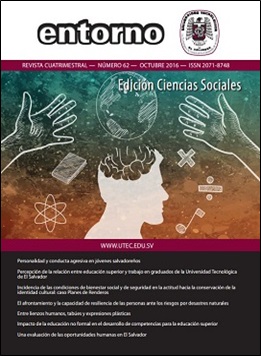The coping and resilience of people facing the risks of natural disasters
DOI:
https://doi.org/10.5377/entorno.v0i62.6086Keywords:
Natural disasters - El Salvador, Resilience (Psychology), Cyclical PhenomenaAbstract
The goal of this study was to identify the existence of a pattern of sociodemographic characteristics in people residing in Barrio Santa Anita, in the metropolitan area of San Salvador, El Salvador, in relation to the existence of an active coping at the emergence of natural disasters. This is a correlational study where Sperman correlations and no parametric tests were used. The sample consisted of 244 residents, 54 % of which were male and 46 % female. A two-scale survey was used: coping strategies and extreme risks as adapted by López Vásquez and Marván (2004) and also an ad-hoc survey adapted from the López-Calleja and Núñez (2014). Some of the results showed the following elements: there are differences in the way people cope with natural disasters based on their age. There are no relevant statistical differences in active coping among men and women; however, the latter showed higher median results in passive coping. In regards to their marital status, there are no differences between this and coping either passively or actively. The participants show a higher level of confidence in the information provided by the city hall and protection Civil [Civil Protection] about the dangers to be faced before natural disasters. Active coping is related with the security of homes, water supply availability and the update of prevention plans. However, most families show passive coping.
Entorno, october 2016, issue 62: 34-46
Downloads
2428
Downloads
Published
How to Cite
Issue
Section
License
© Entorno
It is required that the authors transfer the right of re-production of their articles to the Entorno Journal

